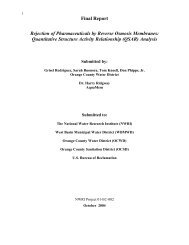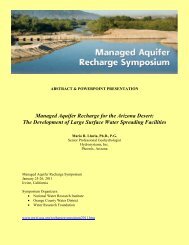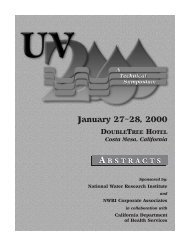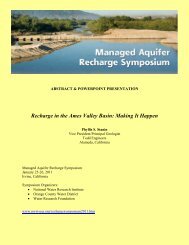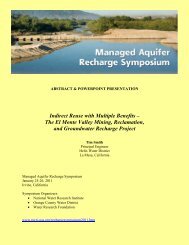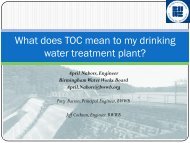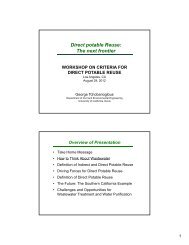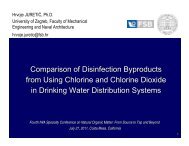RBF_Cover (for eps) - National Water Research Institute
RBF_Cover (for eps) - National Water Research Institute
RBF_Cover (for eps) - National Water Research Institute
You also want an ePaper? Increase the reach of your titles
YUMPU automatically turns print PDFs into web optimized ePapers that Google loves.
Cost-Evaluation of Riverbank Filtration<br />
The capital cost of a <strong>RBF</strong> system depends on many factors, including aquifer characteristics, type<br />
of well-screen installation (vertical or horizontal), aesthetic considerations in facility design, and<br />
distance to the population served. The operational costs vary as a function of water quality and<br />
required treatment, lift required in pumping, and pump and well-screen maintenance costs. The<br />
ability of a stream to support a given well-field capacity can be calculated as the yield per unit<br />
length of riverbank. This capacity is influenced by the composition of the riverbed, riverbed<br />
scouring characteristics, stream-water quality, and width of the river.<br />
Large river systems situated in glacial sands and gravels (such as the Ohio, Mississippi, and Rhine<br />
rivers) can sustain yields up to 8 million gallons per day (MGD) per 1,000 feet (ft) of riverbank.<br />
Typical installations in these aquifers include 1.5-MGD vertical wells spaced on 200-ft centers, or<br />
15-MGD horizontal collector wells spaced at 2,000-ft centers.<br />
The 20-MGD horizontal collector well system constructed in Louisville in 1999 cost $5 million.<br />
The system included:<br />
• Seven laterals that are 200 to 240 ft in length.<br />
• A 21-ft diameter, 100-ft deep caisson.<br />
• A pump house and controls with one constant speed and one variable speed pump<br />
(both 10 MGD).<br />
• Two thousand feet of 42-inch discharge piping to the plant.<br />
The pump house was designed to include architectural features complimentary to surrounding<br />
residential neighborhoods. This system can peak at over 20 MGD in warm weather and is operated<br />
year-round at 17 MGD.<br />
When this system was being considered, alternative treatment techniques <strong>for</strong> surface-water treatment<br />
were also evaluated. Critical treatment functions included efficiency in removing Giardia and<br />
Cryptosporidium, ability to remove 2-methylisoborneol and Geosmin, and DBP reduction. Suitable<br />
alternatives were determined from the matrix and evaluated <strong>for</strong> cost. This process was repeated<br />
twice, by two separate consultants: once in the initial planning stages of the 20-MGD project<br />
(1995), and again just be<strong>for</strong>e a contract was let to design a 45-MGD expansion of the system<br />
(2002).<br />
The surface-water treatment process selected in the final cost analysis as providing comparable<br />
benefits to the overall benefits of <strong>RBF</strong> included: conventional treatment, ozone and biological<br />
treatment in GAC-capped filters, and UV/chlorine/chloramine disinfection. Treatment costs,<br />
however, were also estimated <strong>for</strong> separate elements of this treatment scheme (as was the cost of<br />
membranes) <strong>for</strong> the 180-MGD treatment plant at Crescent Hill.<br />
The results of this cost comparison are included in Table 2. The capital costs were amortized over<br />
20 years in this analysis, and the operation and maintenance (O&M) costs include the treatment<br />
costs to reduce hardness from 220 to 160 milligrams per liter (mg/L). Based on this analysis, the<br />
decision was made to proceed with the development of <strong>RBF</strong> <strong>for</strong> the entire capacity of the 60-MGD<br />
B.E. Payne <strong>Water</strong> Treatment Plant, and to continue considering <strong>RBF</strong> <strong>for</strong> the larger 180-MGD<br />
capacity Crescent Hill Treatment Plant.<br />
5



